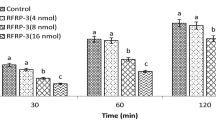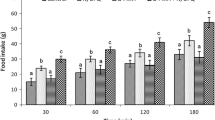Abstract
The present study was designed to determine the effect of central injection of Nesfatin-1 and corticotropin and histaminergic systems on food intake in neonatal meat-type chicks. In this study, 7 experiments were designed, each with 4 treatment groups. In experiment 1, four groups of chicks received the ICV injection of (A) phosphate-buffered saline (PBS), (B) Nesfatin-1 (10 ng), (C) Nesfatin-1 (20 ng) and (D) Nesfatin-1 (40 ng). In experiment 2, (A) PBS, (B) Astressin-B (CRF1/CRF2 receptors antagonist; 30 µg), (C) Nesfatin-1 (40 ng) and (D) Nesfatin-1 + Astressin-B were injected. In experiments 3–6, chicken received ICV injection of the Astressin2-B (CRF2 receptor antagonist; 30 µg), α-FMH (alpha fluoromethyl histidine; as inhibitor of histidine decarboxylase, 250 nmol), Chlorpheniramine (histamine H1 receptors antagonist, 300 nmol), Famotidine (histamine H2 receptors antagonist, 82 nmol) and Thioperamide (histamine H3 receptors antagonist, 300 nmol) instead of the Astressin-B. Then the cumulative food intake measured until 120 min post-injection. According to the results, ICV injection of Nesfatin-1 dose dependently decreased food intake in neonatal chicks (P < 0.05). Co-injection of the Nesfatin-1 and Astressin-B (CRF1/CRF2) inhibited Nesfatin-1 induced hypophagia (P < 0.05). ICV inejction of the Nesfatin-1 + Astressin-B significantly inhibited the effect of Nesfatin-1 on food intake (P < 0.05). In addition, α-FMH and chlorpheniramine attenuated Nesfatin-1-induced hypophagia in chicks (P < 0.05); while thioperamide significantly amplified the effect of Nesfatin-1 on food intake in chicks (P < 0.05). These results suggested Nesfatin-1 has an anorectic effect in 3-hour food deprived neonatal meat-type chicks and this effect was mediated by corticotropin CRF1/CRF2 as well as histamine H1 and H3 receptors.







Similar content being viewed by others
References
Alizadeh A, Zendehdel M, Babapour V, Charkhkar S, Hassanpour S (2015) Role of cannabinoidergic system on food intake in neonatal layer-type chicken. Vet Res Commun 39:151–157
Atsuchi K, Asakawa A, Ushikai M, Ataka K, Tsai M, Koyama K, Sato Y, Kato I, Fujimiya M, Inui A (2010) Centrally administered nesfatin-1 inhibits feeding behaviour and gastroduodenal motility in mice. Neuroreport 21:1008–1011
Chen P, Hover CV, Lindberg D, Li C (2013) Central urocortin 3 and type2 corticotropin-releasing factor receptor in the regulation of energy homeostasis: critical involvement of the ventromedial hypothalamus. Front Endocrinol (Lausanne) 3:180
Chiba S, Itateyama E, Sakata T, Yoshimatsu H (2009) Acute central administration of immepip, a histamine H3 receptor agonist, suppresses hypothalamic histamine release and elicits feeding behavior in rats. Brain Res Bull 79:37–40
D’Addario C, Micioni Di Bonaventura MV, Puccia M, Romano A, Gaetani S, Ciccocioppo R, Cifani C, Maccarrone M (2014) Endocannabinoid signaling and food addiction. Neurosci Biobehav Rev 47:203–224
Davis JL, Masuoka DT, Gerbrandt LK, Cherkin A (1979) Autoradiographic distribution of L-proline in chicks after intracerebral injection. Physiol Behav 22:693–695
Feng H, Wang Q, Guo F, Han X, Pang M, Sun X, Gong Y, Xu L (2017) Nesfatin-1 influences the excitability of gastric distension-responsive neurons in the ventromedial hypothalamic nucleus of rats. Physiol Res 66(2):335–344
Finelli C, Rossano R, Padula MC, La Sala N, Sommella L, Martelli G (2014) Nesfatin – 1: role as possible new anti obesity treatment. J Obes Weight Loss Ther 4(3):1–4
Fort P, Salvert D, Hanriot L, Jego S, Shimizu H, Hashimoto K, Mori M, Luppi PH (2008) The satiety molecule nesfatin-1 is co-expressed with melanin concentrating hormone in tuberal hypothalamic neurons of the rat. Neuroscience 155:174–181
Furuse M, Matsumoto M, Saito N, Sugahara K, Hasegawa S (1997) The central corticotropin-releasing factor and glucagon-like peptide-1 in food intake of the neonatal chick. Eur J Pharmacol 339:211–214
Furuse M, Ando R, Bungo T, Ao R, ShimoJO M, Masuda Y (1999) Intracerebroventricular injection of orexins does not stimulate food intake in neonatal chicks. Br Poult Sci 40:698–700
Furuse M, Yamane H, Tomonaga S, Tsuneyoshi Y, Denbow DM (2007) Neuropeptidergic regulation of food intake in the neonatal chick: a review. J Poult Sci 44:349–356
Gotoh K, Masaki T, Chiba S, Ando H, Shimasaki T, Mitsutomi K, Fujiwara K, Katsuragi I, Kakuma T, Sakata T, Yoshimatsu H (2013) Nesfatin-1, corticotropinreleasing hormone, thyrotropin-releasing hormone, and neuronal histamine interact in the hypothalamus to regulate feeding behavior. J Neurochem 124:90–99
Guo FF, Xu L, Gao SL, Sun XR, Li ZL, Gong YL (2015) The effects of nesfatin-1 in the paraventricular nucleus on gastric motility and its potential regulation by the lateral hypothalamic area in rats. J Neurochem 132(3):266–275
Hancock AA, Brune ME (2005) Assessment of pharmacology and potential anti-obesity properties of H3 receptor antagonists/inverse agonists. Expert Opin Investig Drugs 14:223–241
Hassanpour S, Zendehdel M, Babapour V, Charkhkar S (2015) Endocannabinoid and nitric oxide interaction mediates food intake in neonatal chicken. Br Poult Sci 56(4):443–451
Itoh E, Fujimiya M, Inui A (1998) Thioperamide, a histamine H3 receptor antagonist, suppresses NPY-but not dynorphin A-induced feeding in rats. Regul Pept 75–76:373–376
Iwasaki Y, Nakabayashi H, Kakei M, Shimizu H, Mori M, Yada T (2009) Nesfatin-1 evokes Ca2 + signaling in isolated vagal afferent neurons via Ca2 + influx through N-type channels. Biochem Biophys Res Commun 390:958–962
Kohno D, Nakata M, Maejima Y, Shimizu H, Sedbazar U, Yoshida N et al (2008) Nesfatin-1 neurons in paraventricular and supra optic nuclei of the rat hypothalamus coexpress oxytocin and vasopressin and are activated by refeeding. Endocrinology 149:1295–1301
Lecklin A, Etu-Seppal P, Stark H, Tuomisto L (1998) Effects of intracerebroventricularly infused histamine and selective H1, H2 and H3 agonists on food and water intake and urine flow in Wistar rats. Brain Res 793:279–288
Meade S, Denbow M (2001) Feeding, drinking, and temperature response of chickens to intracerebroventricular histamine. Physiol Behav 73:65–73
Morimoto T, Yamatodani Y, Yamatodani A (2001) Brain histamine and feeding behavior. Behav Brain Res 124:145–150
Mortazavi S, Gonzalez R, Ceddia R, Unniappan S (2015) Long-term infusion of nesfatin-1 causes a sustained regulation of whole-body energy homeostasis of male Fischer 344 rats. Front Cell Dev Biol 3:22
Oh IS, Shimizu H, Satoh T, Okada S, Adachi S, Inoue K, Eguchi H, Yamamoto M, Imaki T, Hashimoto K, Tsuchiya T, Monden T, Horiguchi K, Yamada M, Mori M (2006) Identification of nesfatin-1 as a satiety molecule in the hypothalamus. Nature 443:709–712
Olanrewaju HA, Thaxton JP, Dozier WA, Purswell J, Roush WB, Branton SL (2006) A review of lighting programs for broiler production. Int J Poult Sci 5(4):301–308
Passani MB, Blandina P, Torrealba F (2011) The histamine H3 receptor and eating behavior. J Pharmacol Exper Ther 336(1):24–29
Prinz P, Teuffel P, Lembke V, Kobelt P, Goebel-Stengel M, Hofmann T, Rose M, Klapp BF, Stengel A (2015) Nesfatin-130–59 injected intracerebroventricularly differentially affects food intake microstructurein rats under normal weight and diet-induced obese conditions. Front Neurosci 9:422
Richard D, Lin Q, Timofeeva E (2002) The corticotropin-releasing factor family of peptides and CRF receptors: their roles in the regulation of energy balance. Eur J Pharmacol 440:189–197
Saito ES, Kaiya H, Tachibana T, Tomonaga S, Denbow DM, Kangawa K, Furuse M (2005) Inhibitory effect of ghrelin on food intake is mediated by the corticotropin-releasing factor system in neonatal chicks. Regul Pept 125:201–208
Sakata T, Ookuma K, Fujimoto K, Fukagawa K, Yoshimatsu H (1991) Histaminergic control of energy balance in rats. Brain Res Bull 27:371–375
Schneider EH, Neumann D, Seifert R (2014) Modulation of behavior by the histaminergic system: lessons from HDC-, H3R- and H4R-deficient mice. Neurosci Biobehav Rev 47:101–121
Shousha S, Kirat D, Naso T (2015) Effect of central and peripheral Nesfatin-1 on food intake in Japanese quail. AASCIT J Biol 1(1):1–9
Stengel A, Tache Y (2013) Role of brain NUCB2/nesfatin-1 in the regulation of food intake. Curr Pharm Des 19:6955–6959
Stengel A, Goebel M, Wang L, Rivier J, Kobelt P, Mönnikes H, Lambrecht NWG, Tache Y (2009) Central nesfatin-1 reduces dark-phase food intake and gastric emptying in rats: differential role of corticotropin-releasing factor2 receptor. Endocrinology 150:4911–4919
Stengel A, Goebel M, Wang L, Tache Y (2010) Ghrelin, des-acyl ghrelin and nesfatin-1 in gastric X/A-like cells: role as regulators of food intake and body weight. Peptides 31:357–369
Taati M, Babapour V, Kheradmand A, Tarrahi MJ (2009) The role of central endogenous histamine and H1, H2 and H3 receptors on food intake in broiler chickens. Iran J Vet Res 10(1):54–60
Taati M, Nayebzadeh H, Khosravinia H, Cheraghi J (2010) The role of the histaminergic system on the inhibitory effect of ghrelin on feed intake in broiler chickens. Iran J Vet Res 11(1):38–45
Tanida M, Gotoh H, Yamamoto N, Wang M, Kuda Y, Kurata Y, Mori M, Shibamoto T (2015) Hypothalamic Nesfatin-1 stimulates sympathetic nerve activity via hypothalamic ERK signaling. Diabetes 64:3725–3736
Van Tienhoven A, Juhasz LP (1962) The chicken telencephalon, diencephalon and mesencephalon in sterotaxic coordinates. J Comp Neurol 118:185–197
Yosten GL, Samson WK (2014) Neural circuitry underlying the central hypertensive action of nesfatin-1: melanocortins, corticotropin-releasing hormone, and oxytocin. Am J Phys Regul Integr Comp Phys 306:R722–R727
Zendehdel M, Hamidi F, Hassanpour S (2015) The effect of histaminergic system on nociceptin/orphanin FQ induced food intake in chicken. Int J Pept Res Ther 21:179–186
Zendehdel M, Baghbanzadeh A, Aghelkohan P, Hassanpour S (2016) Central histaminergic system interplay with suppressive effects of immune challenge on food intake in chicken. Br Poult Sci 57(2):271–279
Zendehdel M, Tirgari F, Shohre B, Deldar H, Hassanpour S (2017) Involvement of GABA and cannabinoid receptors in central food intake regulation in neonatal layer chicks: role of CB1 and GABAA receptors. Br J Poult Sci 19(2):51–60
Acknowledgements
The authors thank the central laboratory (Dr. Rastegar Lab.) of the Faculty of Veterinary Medicine, University of Tehran for cooperation. This research is conducted as a part of the PhD thesis of the first author.
Author information
Authors and Affiliations
Corresponding author
Ethics declarations
Conflict of interest
The authors declare that they have no conflict of interest.
Informed consent
This manuscript does not contain any studies with human subjects performed by any of the authors.
Human and animal rights
All experiments were executed according to the Guide for the Care and Use of Laboratory Animals and were approved by the institutional animal ethics committee.
Rights and permissions
About this article
Cite this article
Heidarzadeh, H., Zendehdel, M., Babapour, V. et al. The effect of Nesfatin-1 on food intake in neonatal chicks: role of CRF1 /CRF2 and H1/ H3 receptors. Vet Res Commun 42, 39–47 (2018). https://doi.org/10.1007/s11259-017-9706-9
Received:
Accepted:
Published:
Issue Date:
DOI: https://doi.org/10.1007/s11259-017-9706-9




